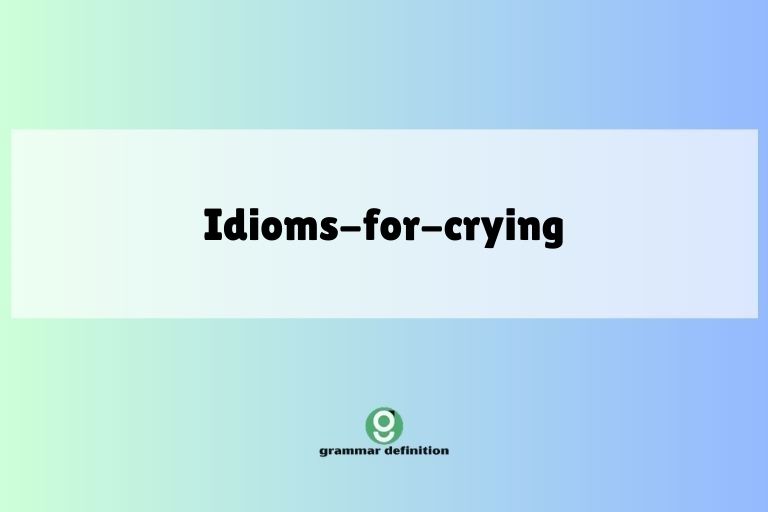Mastering Idioms: A Guide to Conversational English

Idioms are the colorful building blocks of conversational English, adding depth and nuance to everyday communication. Understanding and using idioms effectively can significantly enhance your comprehension and fluency, allowing you to express yourself more naturally and connect with native speakers on a deeper level.
This comprehensive guide explores the world of idioms, providing definitions, examples, usage rules, and practice exercises to help you master this essential aspect of English grammar. This article is designed for English language learners of all levels, from beginners seeking to expand their vocabulary to advanced speakers aiming to refine their conversational skills.
Dive in and discover how idioms can transform your English from functional to fluent!
Table of Contents
- Introduction
- What are Idioms?
- Structural Breakdown of Idioms
- Types of Idioms
- Examples of Idioms in Conversation
- Usage Rules for Idioms
- Common Mistakes with Idioms
- Practice Exercises
- Advanced Topics in Idiom Usage
- Frequently Asked Questions
- Conclusion
What are Idioms?
An idiom is a phrase or expression whose meaning cannot be understood from the literal meanings of its individual words. In other words, idioms are figurative expressions where the overall meaning is different from the combined literal meanings of the words.
They are a vital part of any language, especially English, adding richness, color, and expressiveness to communication. Understanding idioms is crucial for comprehending native speakers and participating effectively in conversations.
Idioms can be classified based on their function and the context in which they are used. Some idioms act as verbs, while others function as adjectives or adverbs.
The context of the sentence is essential in determining the meaning of the idiom. For example, “to kick the bucket” doesn’t literally mean to kick a bucket; it means “to die.” The figurative meaning is the key to understanding idioms.
Classification of Idioms
Idioms can be classified in several ways, including:
- Based on Meaning: Some idioms have clear meanings, while others are more obscure.
- Based on Structure: Some idioms are fixed phrases, while others allow for some variation.
- Based on Function: Some idioms function as verbs, nouns, adjectives, or adverbs.
Function of Idioms
Idioms serve several functions in language:
- Adding Color and Interest: Idioms make language more vivid and engaging.
- Expressing Complex Ideas Simply: Idioms can convey complex emotions or situations in a concise way.
- Creating a Sense of Shared Understanding: Using idioms can create a sense of connection between speakers.
Context of Idioms
The context in which an idiom is used is crucial for understanding its meaning. Consider the following:
- Situation: The overall situation or scenario in which the idiom is used.
- Relationship between Speakers: The relationship between the people who are speaking.
- Tone of Voice: The tone of voice used when speaking.
Structural Breakdown of Idioms
The structure of idioms can vary greatly, making them challenging for language learners. Some idioms are short and simple, while others are long and complex.
Understanding the structural elements of idioms can help learners decipher their meaning and use them correctly.
Many idioms follow common grammatical patterns, such as verb + preposition (e.g., “look after”), verb + adverb (e.g., “give up”), or noun phrases (e.g., “a piece of cake”). Recognizing these patterns can make it easier to identify and understand idioms in context.
However, it’s crucial to remember that the meaning of the idiom is not derived from the individual words but from the phrase as a whole.
Common Idiomatic Patterns
Here are some common patterns found in idioms:
- Verb + Preposition: Look after (take care of), get over (recover from).
- Verb + Adverb: Give up (stop trying), break down (stop functioning).
- Noun Phrases: A piece of cake (easy), a hot potato (a controversial issue).
- Comparisons: As cool as a cucumber (calm), as busy as a bee (very busy).
Fixed Expressions
Many idioms are fixed expressions, meaning that the words and their order cannot be changed. For example, you can’t say “kick the pail” instead of “kick the bucket.” These fixed expressions must be learned as a whole unit.
Variable Expressions
Some idioms allow for some variation. For example, you can say “bend over backwards” or “lean over backwards” to mean the same thing (to try very hard to help someone).
Types of Idioms
Idioms can be categorized based on their function, meaning, or origin. Understanding these categories can help you better understand and use idioms in conversation.
Some common categories include phrasal verbs, proverbs, and clichés.
Phrasal verbs are a type of idiom that consists of a verb and a preposition or adverb. These combinations create new meanings that are different from the individual words. Proverbs are short, well-known sayings that express a general truth or piece of advice. Clichés are idioms that have become overused and lost their original impact.
Phrasal Verbs as Idioms
Phrasal verbs are a specific type of idiom that combines a verb with a preposition or adverb, creating a new meaning. Examples include:
- Look up (search for information).
- Take off (leave or depart).
- Get along (have a good relationship).
Proverbs as Idioms
Proverbs are short, popular sayings that express a common truth or belief. They often use figurative language and are considered idioms.
Examples include:
- A penny saved is a penny earned.
- Actions speak louder than words.
- Don’t count your chickens before they hatch.
Clichés as Overused Idioms
Clichés are idioms that have been used so often that they have become trite and lost their original impact. While they are still idioms, it’s often better to avoid them in formal writing or speaking.
Examples include:
- All that glitters is not gold.
- Time will tell.
- Better late than never.
Examples of Idioms in Conversation
This section provides a wide range of idioms commonly used in English conversations. These examples are organized into tables to make it easier to understand their meanings and usage.
Each table focuses on a specific category or theme, allowing you to learn idioms in a structured and contextualized manner.
The following tables provide examples categorized by common conversational themes, such as work, relationships, and everyday situations. These examples will help you understand how idioms are used in real-life conversations.
Idioms Related to Work
The following table presents idioms commonly used in a work environment. Understanding these idioms can help you navigate workplace conversations more effectively.
| Idiom | Meaning | Example Sentence |
|---|---|---|
| Call it a day | To stop working on something | It’s getting late; let’s call it a day and finish the report tomorrow. |
| Get down to business | To start focusing on work | Okay, everyone, let’s get down to business and discuss the project timeline. |
| Burn the midnight oil | To work late into the night | I had to burn the midnight oil to meet the deadline. |
| Think outside the box | To think creatively and unconventionally | To solve this problem, we need to think outside the box. |
| Hit the ground running | To start something quickly and successfully | The new employee hit the ground running and quickly became a valuable asset. |
| In the same boat | To be in the same difficult situation | We’re all in the same boat when it comes to these budget cuts. |
| A piece of cake | Very easy | The presentation was a piece of cake after all that preparation. |
| Bite the bullet | To face a difficult situation with courage | I didn’t want to work overtime, but I had to bite the bullet. |
| Cut corners | To do something poorly to save money or time | The company cut corners on safety, which led to the accident. |
| Get something off your chest | To talk about something that’s been bothering you | I had to get it off my chest and tell my boss how I felt about the new policy. |
| Keep your eye on the ball | Stay focused | We need to keep our eye on the ball if we want to finish this project on time. |
| Miss the boat | To miss an opportunity | If you don’t apply now, you’ll miss the boat. |
| On the same page | To have the same understanding | It’s important that we’re all on the same page before we start the project. |
| Pull your weight | To do your fair share of work | Everyone needs to pull their weight if we want to succeed. |
| See eye to eye | To agree with someone | We don’t always see eye to eye, but we respect each other’s opinions. |
| The ball is in your court | It’s your turn to take action | I’ve submitted the proposal; now the ball is in your court. |
| Through the grapevine | To hear something through informal communication | I heard through the grapevine that the company is planning layoffs. |
| Up in the air | Uncertain or undecided | The details of the merger are still up in the air. |
| Back to the drawing board | To start over because of failure | The project failed, so it’s back to the drawing board. |
| Easy come, easy go | Something easily obtained is easily lost | He won the lottery, but spent it all quickly; easy come, easy go. |
| Keep head above water | To manage to survive financially | With rising costs, it’s hard to keep my head above water. |
| Learn the ropes | To learn the basics of a job or task | The new intern is still learning the ropes. |
| No-brainer | An easy decision | Hiring him was a no-brainer; he’s perfect for the job. |
| On the back burner | Given low priority | We had to put that project on the back burner due to lack of funding. |
This table illustrates how idioms can add depth and efficiency to workplace communication. By incorporating these idioms into your vocabulary, you can convey your ideas more precisely and engage more effectively with colleagues.
Idioms Related to Relationships
The following table presents idioms commonly used when discussing relationships, whether romantic, familial, or platonic. Understanding these idioms can help you better express your feelings and navigate relationship dynamics.
| Idiom | Meaning | Example Sentence |
|---|---|---|
| Hit it off | To get along well with someone immediately | We hit it off right away and became good friends. |
| See eye to eye | To agree with someone | We don’t always see eye to eye, but we respect each other’s opinions. |
| On the rocks | Having problems and likely to fail | Their marriage has been on the rocks for a while now. |
| Through thick and thin | During good times and bad times | We’ve been friends through thick and thin. |
| Tie the knot | To get married | They’re planning to tie the knot next summer. |
| Wear your heart on your sleeve | To openly show your emotions | He wears his heart on his sleeve, so everyone knows how he’s feeling. |
| Clear the air | To resolve a misunderstanding or disagreement | We need to clear the air and talk about what happened. |
| Get something off your chest | To talk about something that’s been bothering you | I needed to get it off my chest and tell her how I felt. |
| Bury the hatchet | To make peace after a conflict | It’s time to bury the hatchet and move on. |
| A shoulder to cry on | Someone who offers sympathy and support | She’s always been a shoulder to cry on for me. |
| Like two peas in a pod | Very similar and close | They’re like two peas in a pod; they do everything together. |
| Lovey-dovey | Excessively affectionate | They’re always so lovey-dovey; it’s a bit much. |
| Birds of a feather flock together | People with similar interests tend to associate with each other | They’re both artists; birds of a feather flock together. |
| Fall head over heels | To fall deeply in love | He fell head over heels for her the moment they met. |
| Head over heels | Deeply in love | They are head over heels for each other. |
| Have a soft spot for | To feel affection for someone | She has a soft spot for her younger brother. |
| Joined at the hip | Inseparable | Those two are joined at the hip; you never see them apart. |
| Keep someone at arm’s length | To avoid being too close or intimate with someone | He tends to keep people at arm’s length. |
| Know someone inside out | To know someone very well | After all these years, I know her inside out. |
| On the same wavelength | To understand each other well | We’re on the same wavelength, so we rarely argue. |
| A match made in heaven | A perfect pairing | They’re a match made in heaven. |
| Get on like a house on fire | To get along very well | They get on like a house on fire whenever they meet. |
| Give someone the cold shoulder | To ignore someone deliberately | She’s been giving me the cold shoulder ever since the argument. |
| A fair-weather friend | Someone who is only there for you when things are good | He’s a fair-weather friend; he disappeared when I needed help. |
By using these idioms, you can express the nuances of relationships more effectively and connect with others on a deeper emotional level. These expressions add color and authenticity to your conversations about personal connections.
Idioms Related to Daily Life
The table below provides idioms commonly used in everyday situations. Incorporating these idioms into your daily conversations can make your speech more natural and engaging.
| Idiom | Meaning | Example Sentence |
|---|---|---|
| Once in a blue moon | Very rarely | I only go to the cinema once in a blue moon. |
| A piece of cake | Very easy | The exam was a piece of cake. |
| Kill two birds with one stone | To achieve two things with one action | I can kill two birds with one stone by going to the bank on my way to work. |
| Break a leg | Good luck (especially before a performance) | Break a leg with your presentation! |
| Call it a day | To stop working on something | It’s getting late; let’s call it a day. |
| Cost an arm and a leg | Very expensive | That car cost an arm and a leg. |
| Hit the nail on the head | To be exactly right | You hit the nail on the head with that suggestion. |
| Let the cat out of the bag | To reveal a secret | He let the cat out of the bag about the surprise party. |
| Miss the boat | To miss an opportunity | If you don’t apply now, you’ll miss the boat. |
| On cloud nine | Extremely happy | She was on cloud nine after getting the job offer. |
| Under the weather | Feeling ill | I’m feeling a bit under the weather today. |
| Bite off more than you can chew | To take on more than you can handle | He bit off more than he could chew when he volunteered for three projects. |
| Cut to the chase | To get to the point | Let’s cut to the chase; what do you want? |
| Get a taste of your own medicine | To receive the same treatment you’ve given to others | He’s finally getting a taste of his own medicine. |
| In a nutshell | In summary | In a nutshell, the project was a success. |
| Jump on the bandwagon | To join something that is popular | Everyone’s jumping on the bandwagon and buying that phone. |
| Keep your fingers crossed | To hope for good luck | I’m keeping my fingers crossed that I get the job. |
| Last straw | The final problem in a series of problems | That was the last straw; I’m quitting. |
| Make a long story short | To summarize quickly | To make a long story short, we won the game. |
| Out of the blue | Unexpectedly | He called me out of the blue after years of silence. |
| Raining cats and dogs | Raining heavily | It’s raining cats and dogs outside. |
| Speak of the devil | Said when the person you were just talking about appears | Speak of the devil, here he comes! |
| Take with a grain of salt | Do not take it too seriously | You should take what he says with a grain of salt. |
| The elephant in the room | An obvious problem that no one wants to discuss | The company’s financial difficulties are the elephant in the room. |
By familiarizing yourself with these idioms, you can enhance your ability to communicate effectively and naturally in various daily life scenarios. These expressions will help you better understand and participate in everyday conversations.
Usage Rules for Idioms
Using idioms correctly requires understanding their specific meanings and contexts. While idioms can add color and expressiveness to your language, using them inappropriately can lead to confusion or miscommunication.
Therefore, it’s essential to follow certain usage rules to ensure that you’re using idioms effectively.
Context is Key: Always consider the context of the conversation when using an idiom. Make sure that the idiom is appropriate for the situation and the audience. Know the Meaning: Be certain of the idiom’s meaning before using it. Using an idiom incorrectly can change the meaning of your sentence. Avoid Overuse: Using too many idioms in a short period can make your speech sound unnatural or forced.
Contextual Appropriateness
Consider the formality of the situation and the relationship with your audience. Some idioms are more appropriate for informal conversations, while others are suitable for more formal settings.
Avoid using slang or overly casual idioms in professional or academic contexts.
Accuracy of Meaning
Ensure that you fully understand the meaning of the idiom before using it. Misusing an idiom can lead to misunderstandings or even offend your audience.
If you’re unsure about the meaning of an idiom, look it up in a dictionary or ask a native speaker.
Avoiding Overuse
While idioms can enhance your language, overuse can make your speech sound unnatural and forced. Use idioms sparingly and strategically to add emphasis or color to your communication.
Balance your use of idioms with clear, direct language.
Common Mistakes with Idioms
One of the biggest challenges in learning idioms is avoiding common mistakes. Many learners make errors in understanding, using, or translating idioms.
Recognizing these common pitfalls can help you improve your accuracy and fluency.
Literal Interpretation: Interpreting idioms literally is a common mistake. Remember that the meaning of an idiom is different from the combined literal meanings of its individual words. Incorrect Word Order: Many idioms are fixed expressions, meaning that the word order cannot be changed. Changing the word order can alter the meaning or make the idiom nonsensical. Misunderstanding Connotations: Some idioms have specific connotations or emotional associations. Using an idiom with the wrong connotation can lead to misunderstandings.
Literal Interpretation Errors
A common mistake is to interpret idioms literally, which can lead to confusion and miscommunication. For example, if someone says “it’s raining cats and dogs,” they don’t literally mean that animals are falling from the sky.
They mean that it’s raining heavily.
Incorrect: “I was surprised when cats and dogs fell from the sky.”
Correct: “It was raining cats and dogs.”
Incorrect Word Order Errors
Many idioms are fixed expressions, meaning that the words and their order cannot be changed. Changing the word order can alter the meaning or make the idiom nonsensical.
Incorrect: “The bucket kick.”
Correct: “Kick the bucket.”
Misunderstanding Connotations Errors
Some idioms have specific connotations or emotional associations. Using an idiom with the wrong connotation can lead to misunderstandings or even offend your audience.
Incorrect: (Using a humorous idiom in a serious situation)
Correct: (Using a serious idiom in a serious situation)
Practice Exercises
This section provides several practice exercises to help you reinforce your understanding of idioms. These exercises include multiple-choice questions, fill-in-the-blank exercises, and sentence completion tasks.
Each exercise is designed to test your knowledge of idiom meanings and usage.
The following exercises will help you identify and use idioms correctly in different contexts. Pay close attention to the instructions and use the knowledge you’ve gained from the previous sections to answer the questions.
Exercise 1: Multiple Choice
Choose the correct meaning of the idiom in each sentence.
| Question | Options | Answer |
|---|---|---|
| 1. He was feeling under the weather today. | a) happy b) sad c) ill d) energetic | c) ill |
| 2. The project was a piece of cake. | a) difficult b) easy c) long d) boring | b) easy |
| 3. They decided to call it a day. | a) start working b) continue working c) stop working d) take a break | c) stop working |
| 4. She let the cat out of the bag. | a) bought a pet b) revealed a secret c) made a mistake d) told a story | b) revealed a secret |
| 5. That car cost an arm and a leg. | a) was cheap b) was expensive c) was free d) was stolen | b) was expensive |
| 6. He hit the nail on the head. | a) made a mistake b) was exactly right c) was completely wrong d) caused an accident | b) was exactly right |
| 7. They see eye to eye on most things. | a) disagree b) agree c) argue d) fight | b) agree |
| 8. He did that once in a blue moon. | a) frequently b) rarely c) never d) always | b) rarely |
| 9. They hit it off immediately. | a) argued b) disliked each other c) got along well d) ignored each other | c) got along well |
| 10. The relationship is on the rocks. | a) stable b) improving c) failing d) perfect | c) failing |
Exercise 2: Fill in the Blanks
Fill in the blanks with the correct idiom from the list: raining cats and dogs, a piece of cake, under the weather, call it a day, hit the nail on the head.
| Question | Answer |
|---|---|
| 1. It’s ___________ outside; I’m staying home. | raining cats and dogs |
| 2. The test was ___________; I finished it in 30 minutes. | a piece of cake |
| 3. I’m feeling ___________ today, so I’m taking a day off. | under the weather |
| 4. It’s late; let’s ___________ and go home. | call it a day |
| 5. You ___________ with that explanation; it’s perfect. | hit the nail on the head |
| 6. He is feeling ____________ because he has a bad flu. | under the weather |
| 7. The final exam was ____________ for her because she had studied diligently. | a piece of cake |
| 8. Since it started ____________, the outdoor event had to be cancelled. | raining cats and dogs |
| 9. After a long day of work, they decided to ____________ and relax. | call it a day |
| 10. With his insightful comments, he ____________ in the meeting. | hit the nail on the head |
Exercise 3: Sentence Completion
Complete each sentence using an appropriate idiom.
| Question | Answer |
|---|---|
| 1. If you keep working hard, you’ll eventually ___________. | reap the rewards |
| 2. He was so nervous that he had ___________. | butterflies in his stomach |
| 3. I tried to help, but I ended up ___________. | making things worse |
| 4. They were so different that they were like ___________. | chalk and cheese |
| 5. She finally decided to ___________. | take the plunge |
| 6. He always manages to ___________. | get away with it |
| 7. It’s important to ___________. | think outside the box |
| 8. They’ve been ___________. | through thick and thin |
| 9. I heard it ___________. | through the grapevine |
| 10. Don’t count your chickens ___________. | before they hatch |
Advanced Topics in Idiom Usage
For advanced learners, understanding the nuances of idiom usage, including their origins, cultural significance, and variations, can significantly enhance their fluency and cultural competence. Exploring these advanced topics allows you to use idioms more effectively and appropriately.
Idiom Origins: Understanding where idioms come from can provide deeper insights into their meanings and usage. Many idioms have historical or cultural roots that shed light on their figurative meanings. Cultural Significance: Idioms often reflect cultural values and beliefs. Using idioms appropriately requires an understanding of these cultural nuances. Idiom Variations: Some idioms have regional or dialectal variations. Being aware of these variations can help you understand and communicate with people from different regions.
Exploring Idiom Origins
Many idioms have fascinating origins that provide insights into their meanings. For example, the idiom “kick the bucket” is believed to come from the practice of hanging animals to slaughter them, where they would kick the bucket supporting them.
Understanding Cultural Significance
Idioms often reflect cultural values and beliefs. For example, the idiom “bring home the bacon” reflects the traditional role of the male as the breadwinner in a family.
Recognizing Idiom Variations
Some idioms have regional or dialectal variations. For example, the idiom “raining cats and dogs” is more common in British English, while “it’s pouring” is more common in American English.
Frequently Asked Questions
This section addresses some frequently asked questions about idioms. These questions and answers provide further clarification and insights into the topic.
- What is the best way to learn idioms?
The best way to learn idioms is through exposure and practice. Read books, watch movies, and listen to conversations in English. Pay attention to how native speakers use idioms and try to incorporate them into your own speech and writing. Use flashcards or apps to memorize idioms and their meanings. Practice using idioms in context by writing sentences or participating in conversations.
- How can I avoid misusing idioms?
To avoid mis
using idioms, always double-check their meanings and usage in reliable sources. Pay attention to the context in which the idiom is used and consider your audience. If you’re unsure about an idiom, it’s better to use a more straightforward expression.
- Are idioms universal across different languages?
No, idioms are not universal. Each language has its own unique set of idioms that reflect its culture and history. While some idioms may have similar meanings across languages, they are often expressed differently. Direct translation of idioms from one language to another can often lead to nonsensical or incorrect meanings.
- How important is it to learn idioms for English proficiency?
Learning idioms is highly important for achieving advanced English proficiency. While you can communicate effectively without using idioms, understanding and using them can significantly enhance your comprehension, fluency, and cultural competence. Idioms allow you to express yourself more naturally and connect with native speakers on a deeper level.
- Can I use idioms in formal writing?
The use of idioms in formal writing depends on the context and the specific idiom. Some idioms are considered too informal or colloquial for formal writing, while others may be acceptable if they are used sparingly and appropriately. It’s generally best to avoid using overly casual or slangy idioms in formal writing. When in doubt, opt for more direct and straightforward language.
- What resources can I use to learn more idioms?
There are many resources available to help you learn more idioms, including dictionaries, textbooks, websites, and apps. Some popular resources include the Oxford Dictionary of Idioms, the Cambridge International Dictionary of Idioms, and various online idiom lists and quizzes. Additionally, watching English movies and TV shows, reading books, and listening to podcasts can expose you to idioms in context.
- How do I know which idioms are appropriate to use in different situations?
Choosing the right idiom for a given situation requires an understanding of its meaning, connotation, and level of formality. Consider the context of the conversation, your relationship with your audience, and the overall tone of the communication. If you are unsure whether an idiom is appropriate, it’s best to err on the side of caution and use more direct language. Observing how native speakers use idioms in different situations can also help you develop a better sense of appropriateness.
Conclusion
Mastering idioms is a crucial step in achieving fluency and cultural competence in English. While idioms can be challenging to learn, they add color, expressiveness, and depth to your communication.
By understanding the definition, structure, types, and usage rules of idioms, you can avoid common mistakes and use them effectively in various contexts. Practice exercises, advanced topics, and frequently asked questions provide additional resources to enhance your learning journey.
Embrace the world of idioms, and you’ll find your English skills transforming from functional to fluent, allowing you to connect with native speakers on a deeper and more meaningful level. Keep practicing, keep exploring, and enjoy the richness that idioms bring to the English language.






